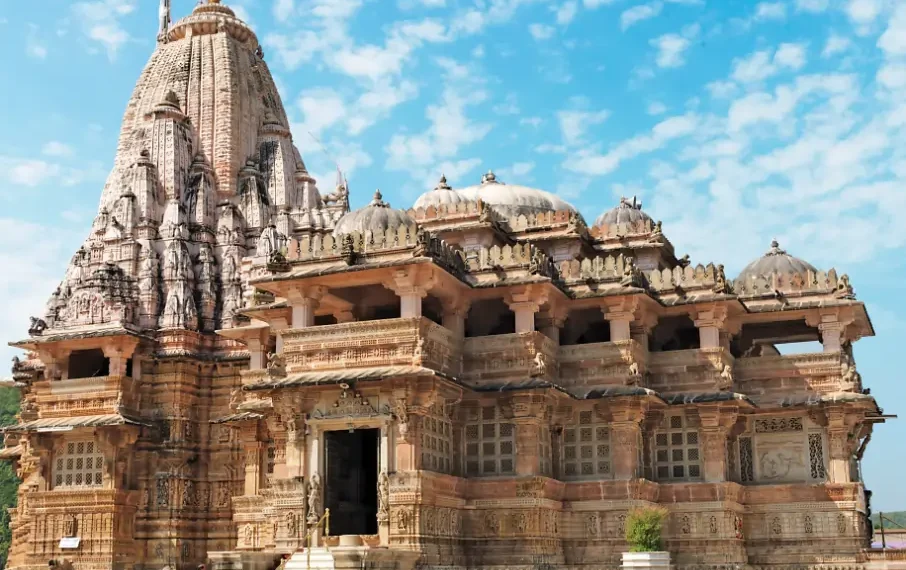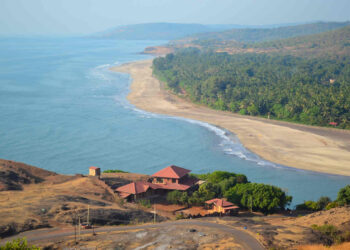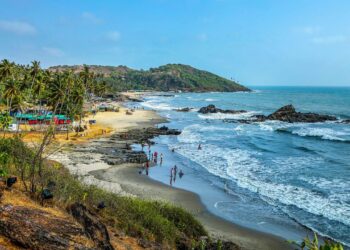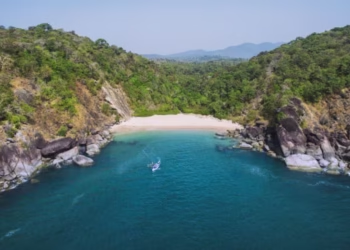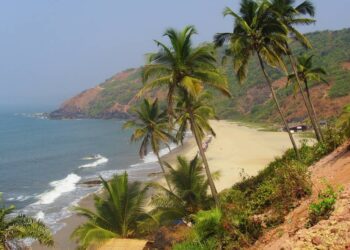Situated by the flowing Meshwo River in the Aravalli district of Gujarat, the Shamlaji Temple is a holy abode where devotees pray to Lord Vishnu, also known as Shamlaji or Krishna. Built around the 11th century by Chaulukya kings, this temple, with its fine stone carvings and wooded hill setting, draws people seeking blessings. If you’re planning to visit this sacred spot, here’s a guide on its story, what it’s like, its prayers, and how to get there.
Fun Fact: The temple’s white silk flag, fluttering high, gives it the name Dholi Dhajawala, meaning “white flag bearer.”
Mythological Importance
Shamlaji Temple holds old tales. One story says Lord Brahma searched for the holiest place on earth and chose Shamlaji, performing intense penance there for a thousand years. Lord Shiva, pleased, told him to perform a yajna, and Vishnu appeared as Shamlaji. Another tale tells of Vishwakarma, the gods’ builder, making the temple in one night but leaving it here at dawn. A third story says an Adivasi found the Shamlaji idol while plowing his field, and his prayers brought him riches. Locals believe praying here washes away sins and brings peace. For Vaishnavites, it’s one of 154 key pilgrimage sites of Sri Vishnu.
Historical Overview
The temple began around 1050 CE under Chaulukya kings, though its current form is from the 15th-16th centuries. Shamlaji was a holy spot long before, with Vishnu worship in the area. A stone from 1584 CE marks repairs, and a copper plate from 1762 CE notes fixes by Tintoi’s Thakor. In the 13th century, invaders harmed it, but Idar rulers restored it. By the 1800s, Jains briefly held it, but Vaishnava merchants rebuilt it. After 1947, the Shamlaji Vishnu Mandir Trust took over. Repairs in the 1900s kept its old look. Saints and poets of Gujarat praised Shamlaji, making it famous. Today, thousands visit Aravalli’s sacred hills.
The temple’s past is rich. Gupta-era idols from the 6th century, found nearby, show its age. British notes from the 1800s call it grand. Fossils and ruins around Shamlaji hint at a city from 1500 years ago.
Architecture of Shamlaji Temple
Shamlaji Temple, on 5 acres by the Meshwo River, is built in Chaulukya-style architecture. The main shrine, from the 15th century, has a tall spire with carvings of Vishnu with a mace, Krishna with cows, and scenes from the Ramayana, all in sandstone. The sanctum holds a black stone idol of Vishnu as Gadadhar, 3 feet tall, with four arms holding a mace, disc, lotus, and conch, recently given a tiny flute to honor Krishna. The idol, from the 7th century, glows under lamps. The sanctum’s walls have marble slabs with Mahabharata tales.
The temple has a sabha mandapa with 20 pillars, carved with dancers and gods. Smaller shrines for Ganesha, Shiva, and Lakshmi are in the complex, made of brick and sandstone. The Ganesha shrine, from the 6th century, shows him standing, for wisdom. The Shiva shrine, called Trilokeshwar, has a 6th-century idol with a trident, for strength. The Lakshmi shrine depicts her with lotuses, for wealth. The grounds, with stone paths, feel holy, surrounded by Aravalli hills. Two giant elephant statues guard the gate. A nearby pool, Karmanu, is used for ritual baths. Pillars show Krishna’s cowherd days, teaching devotees. The white flag atop the temple adds grace.
Rituals and Festivals
The temple shines during festivals. Kartik Purnima, in October or November, is biggest, with a grand fair, oil lamps, and tribal dances by the Bhil community. Vaikuntha Ekadashi, in December or January, brings fasting and Vishnu prayers. Ram Navami, in April, celebrates Rama with a rath yatra. Janmashtami, in August, honors Krishna’s birth with bhajans. Diwali, in October or November, lights up with lamps and sweets.
Daily rituals start with Mangla aarti at dawn, then Abhishekam, with milk and water. Evening aarti, with lamps, ends the day. Special pujas, like Vishnu Homam, is also offered by the devotees for his blessings. A stall gives free laddoos as prasad. Sunday pujas, with tulsi leaves, seek health and calm.
The Kartik fair fills the grounds with joy. The Karmanu pool, believed to cleanse sins, sees devotees bathing during festivals.
Information for Travelers
Hours and Entry: Open daily, 6:00 AM to 12:30 PM, then 2:15 PM to 8:30 PM. Entry is free, but pujas cost ₹100-400. Photography is allowed outside, not in the sanctum.
Clothing: Wear attire covering shoulders and knees. Women for rituals wear sarees or suits, men wear kurtas.
How to Get There:
Air: Ahmedabad Airport, 125 km away, is nearest. Taxis take 2.5 hours, costing ₹2500-3500.
Train: Shamlaji Road Station, 14 km away, links to Ahmedabad (4 hours). Autos cost ₹100-200.
Road: Buses from Ahmedabad (2.5 hours) or Himmatnagar (1 hour) reach Shamlaji. Taxis cost ₹1500-2000. It’s off National Highway 8.
Places to Stay: Shamlaji has guesthouses like Hotel Mangal Murti (₹1000-2000), 900 meters away. Himmatnagar, 50 km, has Hotel Ruturaj (₹2000-3000). Stalls sell dhokla, khaman, and tea.
Best Time to Visit: October to March is cool, 20-30°C. Weekdays are quiet. Kartik Purnima is busy, so book early.
Nearby Attractions:
Harishchandrani Chauri, 1 km away, is a 9th-century temple.
Kashi Vishwanath Temple, 5 km away, is a Shiva shrine.
Dev Ni Mori, 2 km away, is a 4th-century Buddhist site.
Shyamal Van, 10 km away, is a themed garden.
Meshwo Dam, 5 km away, is a scenic spot.
Final Thoughts
Shamlaji Temple in Aravalli, Gujarat, a sacred haven in western India, is a gem of faith. Lord Vishnu’s divine touch fills its hills, making it a must-see among India’s holy sites.
